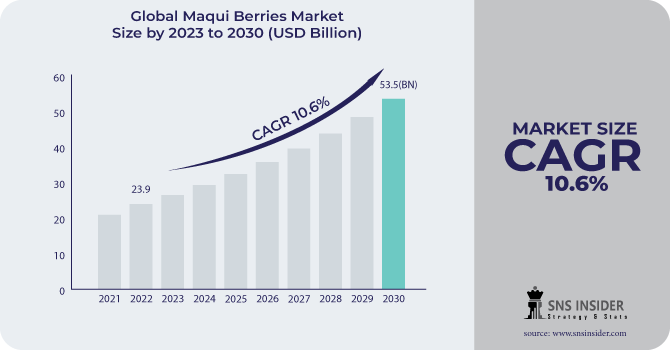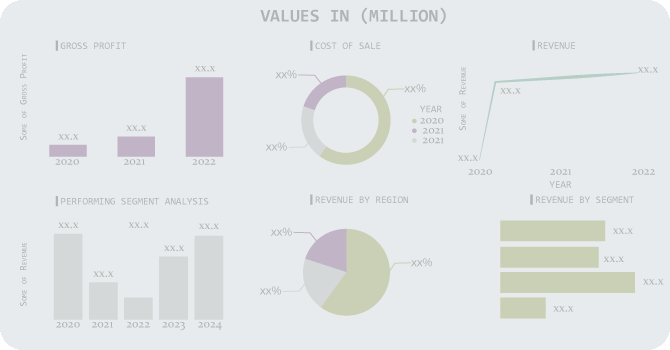Maqui Berries Market Report Scope & Overview:
The Maqui Berries Market size was USD 23.9 billion in 2022 and is expected to Reach USD 53.5 billion by 2030 and grow at a CAGR of 10.6% over the forecast period of 2023-2030.
Maqui berries are a variety of berries found in Chile and Argentina. They have an acidic, sour flavor and are dark purple in appearance. Maqui berries have a high antioxidant content, which has been related to a variety of health advantages.

Based on nature, the conventional segment holds a market share of around 70% and is estimated at 754.3 Metric Tons in 2022 and is anticipated to dominate the industry during the forecast period. Conventional maqui berries are produced using usual agricultural methods, such as synthetic fertilizers and pesticides. This is in contrast to organic maqui berries, which are grown utilizing organic farming methods that are more environmentally friendly and sustainable.
Based on end-users, the dietary supplement segment is expected to have a 49% market share in 2022 and is predicted to grow at a CAGR of 11% during the forecast period. Maqui berry dietary supplements come in a range of forms, including capsules, pills, powders, and liquids. Maqui berry supplements are typically created by grinding or encapsulating dried or freeze-dried maqui berries.
MARKET DYNAMICS
KEY DRIVERS
-
Raising awareness of maqui berries' health benefits
Maqui berries are high in antioxidants, vitamins, and minerals and have been linked to a variety of health benefits such as improving cardiovascular health, lowering the risk of chronic diseases such as cancer and Alzheimer's disease, it also helps to boost the immune system, and promoting gut health. Demand for maqui berries is projected to rise as customers become more aware of their health benefits. Companies in the maqui berry market are helping to raise customer awareness by educating them about the health advantages of maqui berries via social media, marketing efforts, and partnerships with health professionals.
RESTRAIN
-
Limited availability of fresh maqui berries
Maqui berries are a seasonal fruit that is only available for a short period each year, usually from January to March. This has the potential to reduce the supply of fresh maqui berries and drive up costs. Furthermore, because maqui berries are a delicate fruit, they might be difficult to carry and store. This can make getting fresh maqui berries to markets outside of South America problematic. Many businesses rely on frozen, dried, or powdered maqui berries due to the scarcity of fresh maqui berries. Maqui berries in this form have a longer shelf life and are easier to carry and store. However, they may lack the flavor and nutritional value of fresh maqui berries.
OPPORTUNITY
-
Expansion of maqui berries product in new markets
Some parts of the world, like Asia and Africa, still have relatively untapped markets for maqui berries. Businesses have a chance to grow in these areas and raise consumer awareness of the health benefits of maqui berries. Companies who want to sell their maqui berry products in new areas can collaborate with regional distributors. This can assist businesses in reaching a larger audience and overcoming logistical difficulties. To directly access customers in new markets, businesses can create online sales channels. This can assist businesses in overcoming logistical difficulties and cutting expenses.
-
Innovation of new maqui berries product
CHALLENGES
-
Lack of awareness of maqui berries in some markets
Maqui berries are a new fruit to many regions of the world, and many people are unaware of their health advantages or how to use them. This may reduce demand for maqui berries and make it difficult for businesses to advertise their products. Companies can also make it easier for customers to buy maqui berries by offering them in many forms, such as fresh, frozen, dried, and powdered. This will provide consumers with additional options and make it easier for them to pick a type of maqui berry that they prefer.
-
High prices of maqui berries
IMPACT OF RUSSIAN-UKRAINE WAR
Russia and Ukraine produced over 20% of the world's maqui berries in 2022. The war has disrupted the supply of berries there is a reduction in the production of supplements and transportation of maqui berries. This has increased the price of inputs like packaging, fuel, and fertilizer and has also soared in use in maqui berries as a result of the war. As a result, maqui berries are now more expensive. In a recent survey, Patagonia Sur Berries, a major maqui berry producer, discovered that 60% of its clients had seen an increase in maqui berry prices since the commencement of the conflict in Ukraine.
IMPACT OF ONGOING RECESSION
The recession had impacted the sectors related to maqui berries. The demand for maqui berries is expected to decline by 3% in 2022 as a consequence of their increased cost. In a recent survey, Patagonia Sur Berries, a major maqui berry producer, discovered that 30% of its clients claimed they would cut back on maqui berry purchases during an economic downturn. However, even in a recession, 70% of consumers stated they would keep buying maqui berries. The high prices of maqui berries have decreased their use in cosmetics, dietary supplements, food, beverages, and other sectors.
MARKET SEGMENTATION
By Nature
-
Organic
-
Conventional
By Form
-
Fresh
-
Processed
By Distribution Channel
-
Supermarket/ Hypermarket
-
Convenience store
-
Specialty Stores
-
Online Retail
-
Others
By End Use
-
Food
-
Beverage
-
Dietary supplements
-
Personal Care & Cosmetics
-
Others
.png)
REGIONAL ANALYSIS
North America dominates the maqui berry market, accounting for 62% of the global market share in 2022. Due to the rising demand for superfoods and organic antioxidants, maqui berries are becoming more and more well-known in the United States. Products made from maqui berries have been sourced by importers and distributors for the North American market.
The Asia Pacific area is the fastest-growing regional market for maqui berries. This is attributed to increased disposable incomes, increased consumer awareness of the health benefits of maqui berries, and rising demand for Dietary supplements of maqui berries. Japan has witnessed the Maqui berries due to their potential health benefits and antioxidant qualities. Maqui berry products have become popular among Japanese customers.
Europe is the largest regional market for maqui berries, accounting for over 25% of the global market share. The market in Europe is growing rapidly, due to the same factors that are driving growth in the North American market.
The South American region accounts for 30% of the market share. Maqui berries originally came from South America. Brazil comes in second with around 20% of the market, followed by Chile with about 42%. Despite the relatively small size of the Latin American market, it is expanding rapidly as a result of the rising global demand for maqui berries.
REGIONAL COVERAGE
North America
-
US
-
Canada
-
Mexico
Europe
-
Eastern Europe
-
Poland
-
Romania
-
Hungary
-
Turkey
-
Rest of Eastern Europe
-
-
Western Europe
-
Germany
-
France
-
UK
-
Italy
-
Spain
-
Netherlands
-
Switzerland
-
Austria
-
Rest of Western Europe
-
Asia Pacific
-
China
-
India
-
Japan
-
South Korea
-
Vietnam
-
Singapore
-
Australia
-
Rest of Asia Pacific
Middle East & Africa
-
Middle East
-
UAE
-
Egypt
-
Saudi Arabia
-
Qatar
-
Rest of Middle East
-
-
Africa
-
Nigeria
-
South Africa
-
Rest of Africa
-
Latin America
-
Brazil
-
Argentina
-
Colombia
-
Rest of Latin America
KEY PLAYERS
Some major key players in the Maqui Berries Market are Sunfood Superfoods, Maqui New Life S.A., Bayas d el Sur SA, Neorganika, Navitas Organics, Terrasoul Superfoods, Kiva Health Food, Sevenhills Wholefoods, MNL Group, SouthAm Freeze Dry, ARAUCO NUTRIENTES NATURALES, HP Ingredients, and other key players.
Sunfood Superfoods-Company Financial Analysis

RECENT DEVELOPMENTS
In August 2023, CK Nutraceuticals company based in Canada extended its North American distribution agreement with Maqui New Life of Chile for the advertising and distribution of the Maqui berry-derived MaquiBright and Delphinol components.
| Report Attributes | Details |
| Market Size in 2022 | US$ 23.9 Billion |
| Market Size by 2030 | US$ 53.5 Billion |
| CAGR | CAGR of 10.6 % From 2023 to 2030 |
| Base Year | 2022 |
| Forecast Period | 2023-2030 |
| Historical Data | 2019-2021 |
| Report Scope & Coverage | Market Size, Segments Analysis, Competitive Landscape, Regional Analysis, DROC & SWOT Analysis, Forecast Outlook |
| Key Segments | • By Nature (Organic, Conventional) • By Form (Fresh, Processed) • By Distribution Channel (Supermarket/ Hypermarket, Convenience store, Specialty Stores, Online Retail, and Others) • By End Use (Food, Beverage, Dietary supplements, Personal Care & Cosmetics, and Others) |
| Regional Analysis/Coverage | North America (US, Canada, Mexico), Europe (Eastern Europe [Poland, Romania, Hungary, Turkey, Rest of Eastern Europe] Western Europe] Germany, France, UK, Italy, Spain, Netherlands, Switzerland, Austria, Rest of Western Europe]), Asia Pacific (China, India, Japan, South Korea, Vietnam, Singapore, Australia, Rest of Asia Pacific), Middle East & Africa (Middle East [UAE, Egypt, Saudi Arabia, Qatar, Rest of Middle East], Africa [Nigeria, South Africa, Rest of Africa], Latin America (Brazil, Argentina, Colombia Rest of Latin America) |
| Company Profiles | Sunfood Superfoods, Maqui New Life S.A., Bayas d el Sur SA, Neorganika, Navitas Organics, Terrasoul Superfoods, Kiva Health Food, Sevenhills Wholefoods, MNL Group, SouthAm Freeze Dry, ARAUCO NUTRIENTES NATURALES, HP Ingredients |
| Key Drivers | • Raising awareness of maqui berries' health benefits |
| Market Challenges | • Lack of awareness of maqui berries in some markets • High prices of maqui berries |

